The Role of Belgian Airborne Sniffer Measurements in the MARPOL Annex VI Enforcement Chain
Abstract
1. Introduction
1.1. Background to MARPOL Annex VI
1.2. Research Questions
2. Methods and Materials
2.1. Airborne Measurements
2.2. Port Inspections
2.3. Thetis-EU
2.4. FSC Data Validation with Reference Data
2.4.1. FSC Comparison with Fuel Samples
2.4.2. EGCS Data
2.5. Statistical Analysis
3. Results and Discussion
3.1. Follow-Up on Airborne FSC Alerts by Port Inspection Authorities
3.1.1. Results of Onboard Inspections
3.1.2. Results of Onboard Inspections
3.1.3. Comparison of Port Inspection and Airborne Results
3.1.4. Follow-Up on Alerts Based on Thetis-EU
3.1.5. Confirmation Rate of Airborne Alerts in Ports
3.1.6. Follow-Up on EGCS OGV Alerts
3.1.7. Improvement in Port Inspections
3.1.8. Administrative Fines Imposed in Belgian Ports
3.2. Follow-Up Airborne NOx Alerts by Port Inspection Authorities
3.3. FSC Validation
3.3.1. Fuel Samples
3.3.2. EGCS Data
3.3.3. Combined Results
3.4. NOx Validation
3.5. Cost Benefit Analysis
3.5.1. Comparison of Remote Compliance Monitoring with Port Inspections
3.5.2. Comparison with Other Enforcement Methods
3.5.3. Cost per Detected Violation
4. Conclusions
Supplementary Materials
Author Contributions
Funding
Institutional Review Board Statement
Informed Consent Statement
Data Availability Statement
Acknowledgments
Conflicts of Interest
References
- IMO. Protocol of 1997 to Amend the International Convention for the Prevention of Pollution from Ships of 2 November 1973, as Modified by the Protocol of 17 February 1978; International Maritime Organization: London, UK, 1997. [Google Scholar]
- MEPC. RESOLUTION MEPC.259(68) 2015 Guidelines for Exhaust Gas Cleaning Systems; Marine Environment Protection Committee; International Maritime Organization: London, UK, 2015; pp. 1–23. [Google Scholar]
- Endres, S.; Maes, F.; Hopkins, F.; Houghton, K.; Mårtensson, E.M.; Oeffner, J.; Quack, B.; Singh, P.; Turner, D. A New Perspective at the Ship-Air-Sea-Interface: The Environmental Impacts of Exhaust Gas Scrubber Discharge. Front. Mar. Sci. 2018, 5, 139. [Google Scholar] [CrossRef]
- MEPC. RESOLUTION MEPC.132(53) Amendments to the Annex of the Protocol of 1997 to Amend the International Convention for the Prevention of Pollution from Ships, 1973, as Modified by the Protocol of 1978 Relating Thereto; Marine Environmental Protection Committee; International Maritime Organization: London, UK, 2005; pp. 1–16. [Google Scholar]
- MEPC. RESOLUTION MEPC.194(61) Amendments to the Annex of the Protocol of 1997 to Amend the International Convention for the Prevention of Pollution from Ships, 1973, as Modified by the Protocol of 1978 Relating Thereto; Marine Environment Protection Committee; International Maritime Organization: London, UK, 2010; pp. 1–11. [Google Scholar]
- IMO. Annex VI Regulations for the Prevention of Air Pollution from Ships; International Maritime Organization: London, UK, 2008. [Google Scholar]
- MEPC. RESOLUTION MEPC.280(70) Effective Date of Implementation of the Fuel Oil Standard in Regulation 14.1.3 of MARPOL Annex VI; Marine Environment Protection Committee; International Maritime Organization: London, UK, 2016; pp. 1–3. [Google Scholar]
- MEPC. RESOLUTION MEPC.305(73) Amendments to the Annex of the Protocol of 1997 to Amend the International Convention for the Prevention of Pollution from Ships, 1973, as Modified by the Protocol of 1978 Relating Thereto; Marine Environment Protection Committee; International Maritime Organization: London, UK, 2018; pp. 1–5. [Google Scholar]
- EU. Council Directive 1999/32/EC of 26 April 1999 Relating to a Reduction in the Sulphur Content of Certain Liquid Fuels and Amending Directive 93/12/EEC.; Council of the European Union: Brussels, Belgium, 1999; pp. 13–18.
- EU. Directive 2005/33/EC of the European Parliament and of the Council of 6 July 2005; European Parliament: Strasbourg, French, 2005.
- EU. Commission Implementing Decision (EU.) 2015/253-of 16 February 2015-Laying down the Rules Concerning the Sampling and Reporting under Council Directive 1999/32/EC as Regards the Sulphur Content of Marine Fuels; The European Commission: Brussels, Belgium, 2015; pp. 45–59.
- EU. Directive (EU.) 2016/802 of the European Parliament and of the Council of 11 May 2016 Relating to a Reduction in the Sulphur Content of Certain Liquid Fuels; The European Parliament and the Council of the European Union: Brussels, Belgium, 2016; pp. 58–78.
- Royal Decree. Koninklijk Besluit Inzake MiliEU. Vriendelijke Scheepvaart; Belgisch Staatsblad: Brussels, Belgium, 2020; pp. 63339–63386.
- MEPC. RESOLUTION MEPC.202(62) Amendments to the Annex of the Protocol of 1997 to Amend the International Convention for the Prevention of Pollution from Ships, 1973, as Modified by the Protocol of 1978 Relating Thereto (Designation of the United States Caribbean Sea Emission Control Area and Exemption of Certain Ships Operating in the North American Emission Control Area and the United States Caribbean Sea Emission Control Area under Regulations 13 and 14 and Appendix VII of MARPOL Annex VI); Marine Environment Protection Committee; International Maritime Organization: London, UK, 2011; pp. 2–13. [Google Scholar]
- MEPC. RESOLUTION MEPC.70/5/Rev.1 Proposal to Designate the North Sea as an Emission Control Area for Nitrogen Oxides (Submitted by Belgium et al.); Marine Environment Protection Committee; International Maritime Organization: London, UK, 2016; pp. 1–71. [Google Scholar]
- MEPC. CIRCULAR MEPC.1/Circ.778/Rev.3 List of Special Areas, Emission Control Areas and Particularly Sensitive Sea Areas; Marine Environmental Protection Committee; International Maritime Organization: London, UK, 2018; pp. 1–5. [Google Scholar]
- Heywood, J. Internal Combustion Engine Fundamentals Second Edition, 2nd ed.; McGraw-Hill Education Ltd: London, UK, 2018. [Google Scholar]
- IMO. NOx Technical Code 2008—Amendments to the Technical Code on Control of Emission of Nitrogen Oxides from Marine Diesel Engines (NOx Technical Code 2008); International Maritime Organisation: London, UK, 2008. [Google Scholar]
- MEPC. CIRCULAR MEPC.1/Circ.679 Guidelines for the Application of the NOx Technical Code Relative to Certification and Amendments of Tier I Engines; Marine Environmental Protection Committee; International Maritime Organization: London, UK, 2009. [Google Scholar]
- MEPC. RESOLUTION MEPC.176(58) Amendments to the Annex of the Protocol of 1997 to Amend the International Convention for the Prevention of Pollution from Ships, 1973, as Modified by the Protocol of 1978 Relating Thereto (Revised MARPOL Annex VI); Marine Environment Protection Committee; International Maritime Organization: London, UK, 2008; pp. 1–46. [Google Scholar]
- EU. Revision of the Directive 2005/35/EC on Ship-Source Pollution and on the Introduction of Penalties for Infringements; The European Parliament and the Council of the European Union: Brussels, Belgium, 2022.
- Bloss, M. EU.-CO2-Handel Für Die Schiffahrt Kommt. 2022. Available online: https://michaelbloss.eu/de/presse/themenhintergrund/eu-co2-handel-fuer-die-schiffahrt-kommt (accessed on 22 December 2022).
- EU. Fit for 55 in 2030: Parliament Wants a More Ambitious Emissions Trading System; The European Parliament and the Council of the European Union: Brussels, Belgium, 2022. [Google Scholar]
- EU. Ractiv. EU. Agrees Carbon Market Overhaul in Bid to Hit 2030 Climate Goal; The European Parliament and the Council of the European Union: Brussels, Belgium, 2022.
- European Commission. Proposal for a Directive of the European Parliament and of the Council Amending Directive 2003/87/EC Establishing a System for Greenhouse Gas Emission Allowance Trading within the Union, Decision (EU.) 2015/1814 Concerning the Establishment and Operation of a Market Stability Reserve for the Union Greenhouse Gas Emission Trading Scheme and Regulation (EU.) 2015/757; The European Parliament and the Council of the European Union: Brussels, Belgium, 2021.
- Council of the European Union. Proposal for a Directive of the European Parliament and of the Council Amending Directive 2003/87/EC Establishing a System for Greenhouse Gas Emission Allowance Trading within the Union, Decision (EU.) 2015/1814 Concerning the Establishment and Operation of a Market Stability Reserve for the Union Greenhouse Gas Emission Trading Scheme and Regulation (EU.) 2015/757; The Council of the European Union: Brussels, Belgium, 2022.
- EU. Amendments Adopted by the European Parliament on 22 June 2022 on the Proposal for a Directive of the European Parliament and of the Council Amending Directive 2003/87/EC Establishing a System for Greenhouse Gas Emission Allowance Trading within the Union, Decision (EU.) 2015/1814 Concerning the Establishment and Operation of a Market Stability Reserve for the Union Greenhouse Gas Emission Trading Scheme and Regulation (EU.) 2015/757 (COM(2021)0551-C9-0318/2021-2021/0211(COD)); European Parliament: Brussels, Belgium, 2022.
- Repka, S.; Erkkilä-Välimäki, A.; Jonson, J.E.; Posch, M.; Törrönen, J.; Jalkanen, J.P. Assessing the costs and environmental benefits of IMO regulations of ship-originated SOx and NOx emissions in the Baltic Sea. Ambio 2021, 50, 1718–1730. [Google Scholar] [CrossRef] [PubMed]
- Viana, M.; Rizza, V.; Tobías, A.; Carr, E.; Corbett, J.; Sofiev, M.; Karanasiou, A.; Buonanno, G.; Fann, N. Estimated health impacts from maritime transport in the Mediterranean region and benefits from the use of cleaner fuels. Environ. Int. 2020, 138, 105670. [Google Scholar] [CrossRef] [PubMed]
- Sofiev, M.; Winebrake, J.J.; Johansson, L.; Carr, E.W.; Prank, M.; Soares, J.; Vira, J.; Kouznetsov, R.; Jalkanen, J.P.; Corbett, J.J. Cleaner fuels for ships provide public health benefits with climate tradeoffs. Nat. Commun. 2018, 9, 406. [Google Scholar] [CrossRef] [PubMed]
- Verbeek, R.; Van Dinther, D.; Mamarik, S.; Grigoriadis, A.; Weigelt, A.; Van Vliet, J.; Smyth, T.; Deakin, A.; Irjala, M. SCIPPER Project D5.3 Cost-Effectiveness of Different Approaches for Compliance; The European Parliament and the Council of the European Union: Brussels, Belgium, 2022. [Google Scholar]
- Corbett, J.J.; Fischbeck, P.S. Emissions from Ships. Science 1997, 278, 823–824. [Google Scholar] [CrossRef]
- Gillis, M. Let’s Play? An Examination of the ‘Level Playing Field’ in EU. Free Trade Agreements. J. World Trade 2021, 55, 715–740. [Google Scholar] [CrossRef]
- Van Miert, K. What Does a Level Playing Field Mean in the Global Economy? In Proceedings of the DAVOS World Economic Forum, Davos, Switzerland, 30 January 1998; Available online: https://ec.EU.ropa.EU./competition/speeches/text/sp1998_031_en.html (accessed on 15 December 2022).
- EU. Trade Defence—Ensuring a Level Playing Field; European Parliament: Brussels, Belgium, 2010.
- WHO. World Trade Report 2022-Climate Change and International Trade; World Health Organization: Geneva, Switzerland, 2022.
- Berg, N.; Mellqvist, J.; Jalkanen, J.P.; Balzani, J. Ship Emissions of SO2 and NO2: DOAS Measurements from Airborne Platforms. Atmos. Meas. Tech. 2012, 5, 1085–1098. [Google Scholar] [CrossRef]
- Balzani Lööv, J.M.; Alfoldy, B.; Gast, L.F.L.; Hjorth, J.; Lagler, F.; Mellqvist, J.; Beecken, J.; Berg, N.; Duyzer, J.; Westrate, H.; et al. Field Test of Available Methods to Measure Remotely SOx and NOx Emissions from Ships. Atmos. Meas. Tech. 2014, 7, 2597–2613. [Google Scholar] [CrossRef]
- Van Roy, W.; Schallier, R.; Van Roozendael, B.; Scheldeman, K.; Van Nieuwenhove, A.; Maes, F. Airborne Monitoring of Compliance to Sulfur Emission Regulations by Ocean-Going Vessels in the Belgian North Sea Area. Atmos. Pollut. Res. 2022, 13. [Google Scholar] [CrossRef]
- Van Roy, W.; Van Nieuwenhove, A.; Scheldeman, K.; Van Roozendael, B.; Schallier, R.; Mellqvist, J.; Maes, F. Measurement of Sulfur-Dioxide Emissions from Ocean-Going Vessels in Belgium Using Novel Techniques. Atmosphere 2022, 13, 1756. [Google Scholar] [CrossRef]
- Van Roy, W.; Scheldeman, K.; Van Roozendael, B.; Van Nieuwenhove, A.; Schallier, R.; Vigin, L.; Maes, F. Airborne Monitoring of Compliance to NOx Emission Regulations from Ocean-Going Vessels in the Belgian North Sea. Atmos. Pollut. Res. 2022, 13, 101518. [Google Scholar] [CrossRef]
- Beecken, J.; Irjala, M.; Weigelt, A.; Conde, V.; Mellqvist, J.; Proud, R.; Deakin, A.; Knudsen, B.; Timonen, H.; Sundström, A.-M.; et al. SCIPPER Project D2.1 Review of Available Remote Systems for Ship Emission Measurements; The European Parliament and the Council of the European Union: Brussels, Belgium, 2019. [Google Scholar]
- CompMon. Compliance monitoring pilot for Marpol Annex VI (CompMon), Connection European Facility, 2014-EU.-TM-0546-S; The European Parliament and the Council of the European Union: Brussels, Belgium, 2016.
- Mellqvist, J.; Conde, V. SCIPPER Project D2.2 Prototype of Revised Sniffer Type of Remote Monitor Demonstrator; The European Parliament and the Council of the European Union: Brussels, Belgium, 2022. [Google Scholar]
- Mellqvist, J.; Ekholm, J.; Salo, K.; Beecken, J. Identification of Gross Polluting Ships to Promote a Level Playing Field withing the Shipping Sector; Swedish National Road and Transport Research Institute: Linköping, Sweden, 2014. [Google Scholar]
- Beecken, J.; Mellqvist, J.; Salo, K.; Ekholm, J.; Jalkanen, J.-P. Airborne Emission Measurements of SO2, NOx and Particles from Individual Ships Using a Sniffer Technique. Atmos. Meas. Tech. 2014, 7, 1957–1968. [Google Scholar] [CrossRef]
- Beecken, J.; Mellqvist, J.; Salo, K.; Ekholm, J.; Jalkanen, J.-P.; Johansson, L.; Litvinenko, V.; Volodin, K.; Frank-Kamenetsky, D.A. Emission factors of SO2, NOx and particles from ships in Neva Bay from ground-based and helicopter-borne measurements and AIS-based modelling. Atmos. Chem. Phys. 2015, 15, 5229–5241. [Google Scholar] [CrossRef]
- Alföldy, B.; Lööv, J.B.; Lagler, F.; Mellqvist, J.; Berg, N.; Beecken, J.; Weststrate, H.; Duyzer, J.; Bencs, L.; Horemans, B.; et al. Measurements of air pollution emission factors for marine transportation in SECA. Atmos. Meas. Tech. 2013, 6, 1777–1791. [Google Scholar] [CrossRef]
- Duyzer, J.H.; Weststrate, J.H. Measurements of Fuel Sulphur Content by Measurements in the Plume; Technical report; TNO: Apeldoorn, The Netherlands, 2015. [Google Scholar]
- Van Dinther, D.; Duyzer, J.H.; De Bie, S.; Moerman, M.M.; Lollinga, J.P.; Maarschalkerweerd, T.V.P. Measurements of Emission Factors of Nitrogen Oxides of Seagoing Vessels in the Port of Rotterdam; TNO: Apeldoorn, The Netherlands, 2022. [Google Scholar]
- Weigelt, A. Sulphur emission compliance monitoring of ships in German waters—results from five years of operation. In Shipping and the Environment, Symposium on Scenarios and Policy Options for Sustainable Shipping (POL) Goteborg; BSH: Hamburg, Germany, 2019. [Google Scholar]
- Weigelt, A.; Thomsen, C.; Bliemeister, J. German Ship Emission Monitoring Network Remote Emission Measurements to Support MARPOL Annex VI Compliance Monitoring; BSH: Hamburg, Germany, 2021. [Google Scholar]
- Behrens, L.; Kattner, L.; Mathieu-Üffing, B.; Krause, K.; Meier, A.; Ochmann, S.; Ostendorf, M.; Peters, E.; Richter, A.; Schönhardt, A.; et al. Measurements of Shipping Emissions in the Marine Troposphere-Phase 2: Further Development of Remote Sensing Methods and Implementation into an Operational Network MeSmarT-II. Bremen. 2020. Available online: https://www.bsh.de/DE/PUBLIKATIONEN/_Anlagen/Downloads/Projekte/MeSmarT/Final_Report.html (accessed on 22 December 2022).
- Mellqvist, J.; Beecken, J.; Conde, V.; van Dinther, D.; Duyzer, J.; Griesel, S.; Irjala, M.; Knudsen, B.; Knudsen, J.; Moerman, M.; et al. SCIPPER Project D2.3—Quality assurance of remote monitoring systems and harmonised reporting; The European Parliament and the Council of the European Union: Brussels, Belgium, 2022. [Google Scholar]
- EMSA. RPAS Service Ship Emission Monitoring; European Maritime Safety Agency: Lisbon, Portugal, 2022.
- Enge, S.E. Sulphur Expert Meeting 2018. The Use of Drones for Sulphur Controls, Antwerp. 2018. [Google Scholar]
- Duyzer, J.; Hollander, K.; Marita, V.; Verhagen, H.; Hilbrand, W.; Hensen, A.; Kraai, A.; Kos, G. Assessment of Emissions of PM and NOx of Sea Going Vessels by Field Measurements; TNO: Apeldoorn, The Netherlands, 2007. [Google Scholar]
- Lööv, J.M.B.; Alfoldy, B.; Beecken, J.; Berg, N.; Berkhout, A.J.C.; Duyzer, J.; Gast, L.F.L.; Hjorth, J.; Jalkanen, J.P.; Lagler, F.; et al. Field test of available methods to measure remotely SO2 and NOx emissions from ships. Atmos. Meas. Tech. Discuss. 2013, 6, 9735–9782. [Google Scholar] [CrossRef]
- Au, C.N.; Delea, C.; Schneider, V.E.; Oeffner, J.; Jahn, C. A Web-oriented Architecture for Deploying Multiple Unmanned Vehicles as a Service. TransNav. Int. J. Mar. Navig. Saf. Sea Transp. 2021, 15, 155–162. [Google Scholar] [CrossRef]
- Sokhi, R.S.; Moussiopoulos, N.; Baklanov, A.; Bartzis, J.; Coll, I.; Finardi, S.; Friedrich, R.; Geels, C.; Grönholm, T.; Halenka, T.; et al. Advances in air quality research—current and emerging challenges. Atmos. Chem. Phys. 2022, 22, 4615–4703. [Google Scholar] [CrossRef]
- Smyth, T.; Bell, T.; Fishwick, J.; Yang, M. Reportingship Exhaust Gas Emissions Using Automatic Identification System Technology; Plymouth Marine Laboratory: Plymouth, UK, 2019; Unpublished report. [Google Scholar]
- Prata, A.J. Measuring SO2 ship emissions with an ultraviolet imaging camera. Atmos. Meas. Tech. 2014, 7, 1213–1229. [Google Scholar] [CrossRef]
- Walden, J.; Pirjola, L.; Laurila, T.; Hatakka, J.; Pettersson, H.; Walden, T.; Jalkanen, J.-P.; Nordlund, H.; Truuts, T.; Meretoja, M.; et al. Measurement report: Characterization of uncertainties in fluxes and fuel sulfur content from ship emissions in the Baltic Sea. Atmos. Chem. Phys. 2021, 21, 18175–18194. [Google Scholar] [CrossRef]
- Karjalainen, P.; Teinilä, K.; Kuittinen, N.; Aakko-Saksa, P.; Bloss, M.; Vesala, H.; Pettinen, R.; Saarikoski, S.; Jalkanen, J.P.; Timonen, H. Real-world particle emissions and secondary aerosol formation from a diesel oxidation catalyst and scrubber equipped ship operating with two fuels in a SECA area. Environ. Pollut. 2022, 292, 118278. [Google Scholar] [CrossRef]
- Royal Decree. Wet Tot Invoering van Het Belgisch Scheepvaartwetboek; Belgisch Staatsblad: Gent, Belgium, 2019; pp. 75432–75808.
- MEPC. CIRCULAR MEPC.1/Circ.864/Rev.1 Guidelines for on Board Sampling for the Verification of the Sulphur Content of the Fuel Oil Used on Board Ships; Marine Environment Protection Committee; International Maritime Organization: London, UK, 2019. [Google Scholar]
- Belgisch Staatsblad. Wet van 25 December 2016 Tot Vaststelling van Administratieve Geldboetes van Toepassing in Geval van Inbreuken Op de Scheepvaartwetten; Belgisch Staatsblad: Gent, Belgium, 2017; pp. 3439–3446. [Google Scholar]
- EMSA. Thetis-EU. 2022. Available online: Https://Portal.Emsa.europa.EU./Web/Thetis-EU (accessed on 16 December 2022).
- MEPC. RESOLUTION MEPC.184(59) Guidelines for Exhaust Gas Cleaning Systems; Marine Environment Protection Committee; International Maritime Organization: London, UK, 2009; pp. 1–26. [Google Scholar]
- Devore, J.; Berk, K.; Carlton, M. Modern Mathematical Statistics with Applications, 3rd ed.; Springer: Berlin/Heidelberg, Germany, 2011. [Google Scholar]
- Gardner, M.J.; Altman, D.G. Estimating with Confidence. BMJ 1988, 296, 1210–1211. [Google Scholar] [CrossRef] [PubMed]
- Sprinthall, R.C. Basic Statistical Analysis, 9th ed.; Pearson: London, UK, 2011. [Google Scholar]
- Martin Bland, J.; Altman, D.G. Statistical Methods for Assessing Agreement Between two Methods of Clinical Measurement. Lancet 1986, 327, 307–310. [Google Scholar] [CrossRef]
- Altman, D.G.; Bland, J.M. Measurement in Medicine: The Analysis of Method Comparison Studies. Statistician 1983, 32, 307. [Google Scholar] [CrossRef]
- EMSA. COVID-19 Impact on Shipping; European Maritime Safety Agency: Lisbon, Portugal, 2021.
- Port State Control Dealing with the Pandemic-Annual Report 2020; Paris MoU: Den Hague, The Netherlands, 2021.
- Airborne Monitoring of Sulphur Emissions from Ships in Danish Waters, 2019 Campaign Results; Explicit ApS: Lyngby-Taarbæk, Denmark, 2020.
- Airborne Monitoring of Sulphur Emissions from Ships in Danish Waters, 2020 Campaign Results; Explicit ApS: Lyngby-Taarbæk, Denmark, 2021.
- Airborne Monitoring of Sulphur Emissions from Ships in Danish Waters, 2018 Campaign Results; Explicit ApS: Lyngby-Taarbæk, Denmark, 2019.
- Airborne Monitoring of Sulphur Emissions from Ships in Danish Waters: 2017 Campaign Results; Danish Environmental Protection Agency: Lyngby-Taarbæk, Denmark, 2018.
- Airborne Monitoring of Sulphur Emissions from Ships in Danish Waters: 2021 Campaign Results; Danish Environmental Protection Agency: Lyngby-Taarbæk, Denmark, 2022.
- Mellqvist, J.; Conde, V. Surveillance of Sulfur Fuel Content in Ships at the Great Belt Bridge 2018; The Danish Environmental Protection Agency: Odense, Denmark, 2019.
- Mellqvist, J.; Conde, V. Surveillance of Sulfur Fuel Content in Ships at the Great Belt Bridge 2019; The Danish Environmental Protection Agency: Odense, Denmark, 2020. [Google Scholar]
- Mellqvist, J.; Beecken, J.; Conde, V.; Ekholm, J. Surveillance of Sulfur Emissions from Ships in Danish Waters 2017; The Danish Environmental Protection Agency: Odense, Denmark, 2018.
- Mellqvist, J.; Beecken, J.; Conde, V.; Van Dinther, D.; Duyzer, J.; Griesel, S.; Irjala, M.; Knudsen, B.; Knudsen, J.; Moerman, M.; et al. THE SCIPPER PROJECT Shipping Contributions to Inland Pollution Push for the Enforcement of Regulations; The European Parliament and the Council of the European Union: Brussels, Belgium, 2022. [Google Scholar]
- Van Roy, W.; Scheldeman, K. Compliance Monitoring Pilot for MARPOL Annex VI, Results MARPOL Annex VI Monitoring Report Belgian Sniffer Campaign 2016; The European Parliament and the Council of the European Union: Brussels, Belgium, 2016. [Google Scholar]
- Van Roy, W.; Scheldeman, K. Compliance Monitoring Pilot for MARPOL Annex VI, Best Practices Airborne MARPOL Annex VI Monitoring; The European Parliament and the Council of the European Union: Brussels, Belgium, 2016. [Google Scholar]
- Majamäki, E.; Jalkanen, J.-P. SCIPPER Project D4.2 Updated Inventories Onregional Shipping Activityand Port Regions; The European Parliament and the Council of the European Union: Brussels, Belgium, 2021. [Google Scholar]
- The Scipper Project. SCIPPER Project Finds High Nitrogen Oxides Emissions of Tier III Vessels from Remote Measurements in North European Seas; The European Parliament and the Council of the European Union: Brussels, Belgium, 2023. [Google Scholar]
- Winnes, H.; Fridell, E.; Verbeek, R.; Duyzer, J.; Weigelt, A.; Mamarikas, S.; Ntziachristos, L. SCIPPER Project D5.1 Gaps in Current Emission Enforcement Regulations and Impacts to Real-World Emissions; The European Parliament and the Council of the European Union: Brussels, Belgium, 2019. [Google Scholar]
- SCIPPER. 2023. Available online: https://www.scipper-project.EU (accessed on 30 January 2023).
- Grigoriadis, A.; Mamarikas, S.; Ntziachristos, L. Emission performance of major ship classes: An estimation based on a new set of emission factors and realistic activity profile data. IOP Conf. Ser. Earth Env. Sci. 2021, 899, 012005. [Google Scholar] [CrossRef]
- Knudsen, B.; Lallana, A.L.; Ledermann, L. NOx Emissions from Ships in Danish Waters Assessment of Current Emission Levels and Potential Enforcement Models; The Danish Environmental Protection Agency: Odense, Denmark, 2022.
- Asad, U.; Kelly, C.; Wang, M.; Tjong, J. Effects of Intake Air Humidity on the NOX Emissions and Performance of a Light-Duty Diesel Engine. In Proceedings of the ASME 2012 Internal Combustion Engine Division Fall Technical Conference, American Society of Mechanical Engineers, Vancouver, BC, Canada, 23–26 September 2012; pp. 235–242. [Google Scholar] [CrossRef]
- Agentschap Maritieme Dienstverlening en Kust. 2019. Available online: https://www.kustweerbericht.be/nl/rapporten (accessed on 2 May 2022).
- Ship and Bunker. Scrubber Equipped Tonnage Now 30% of Boxship Capacity. 2021. Available online: Https://Shipandbunker.Com/News/World/867193-Scrubber-Equipped-Tonnage-Now-30-of-Boxship-Capacity (accessed on 15 June 2022).
- MEPC. RESOLUTION MEPC.79/INF.4 Inspections of Exhaust Gas Cleaning Systems—First Experiences; Marine Environmental Protection Committee; International Maritime Organization: London, UK, 2022. [Google Scholar]

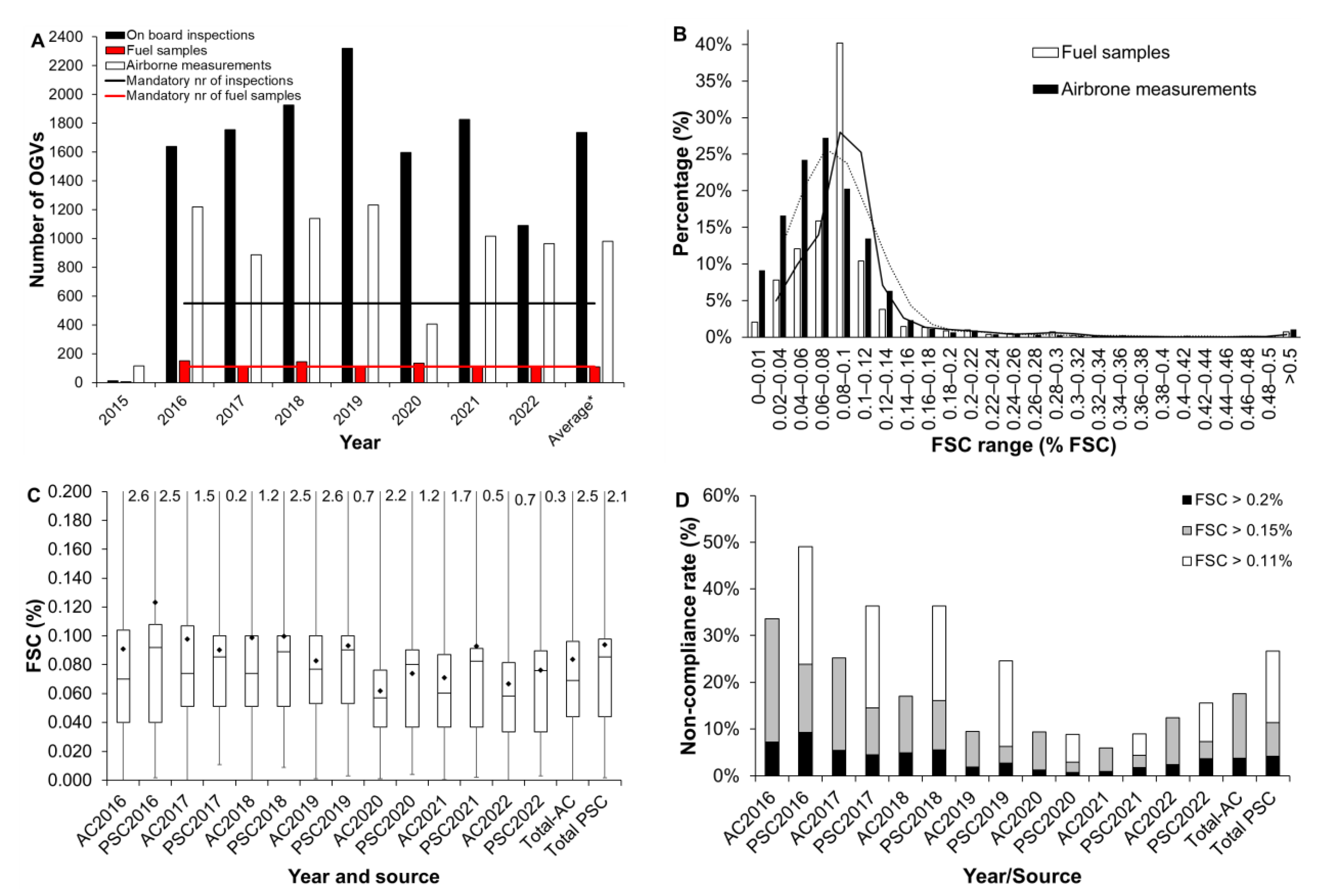
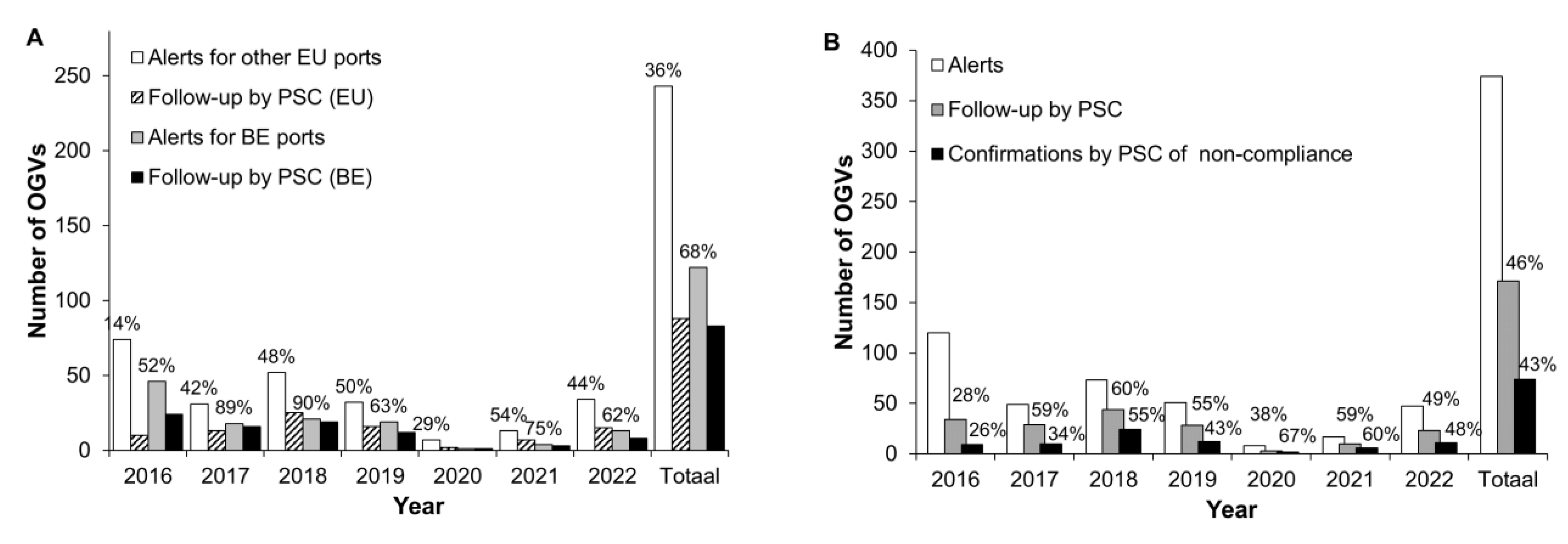
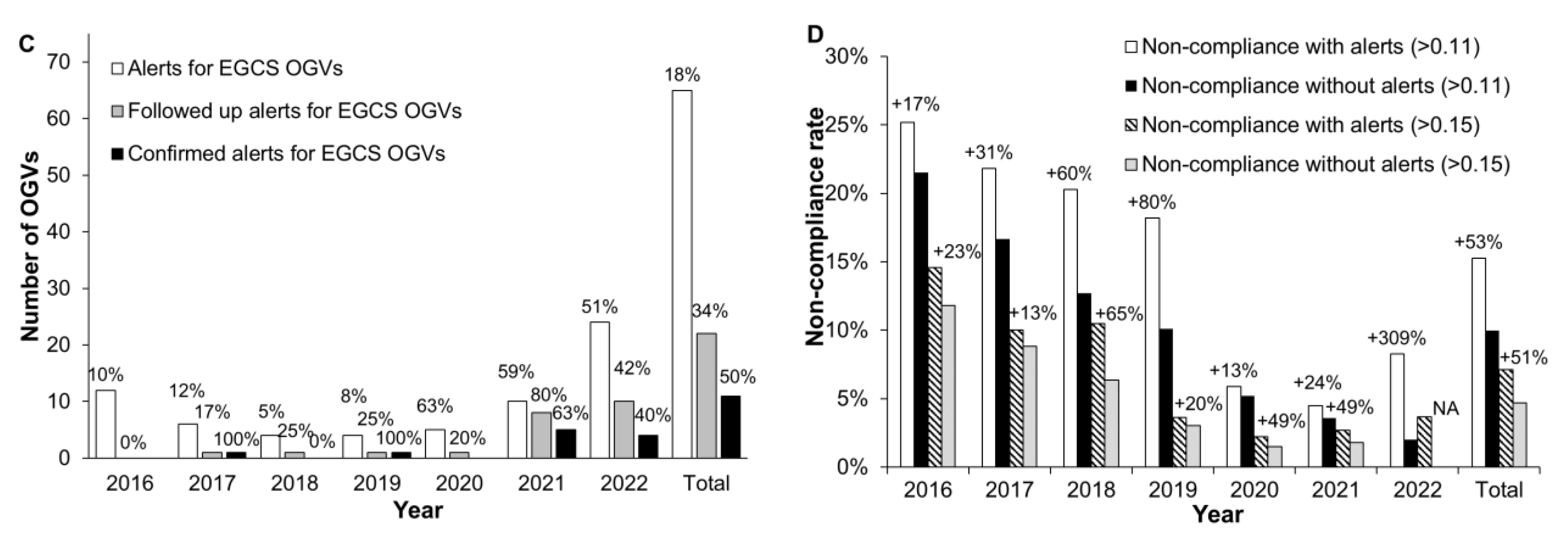
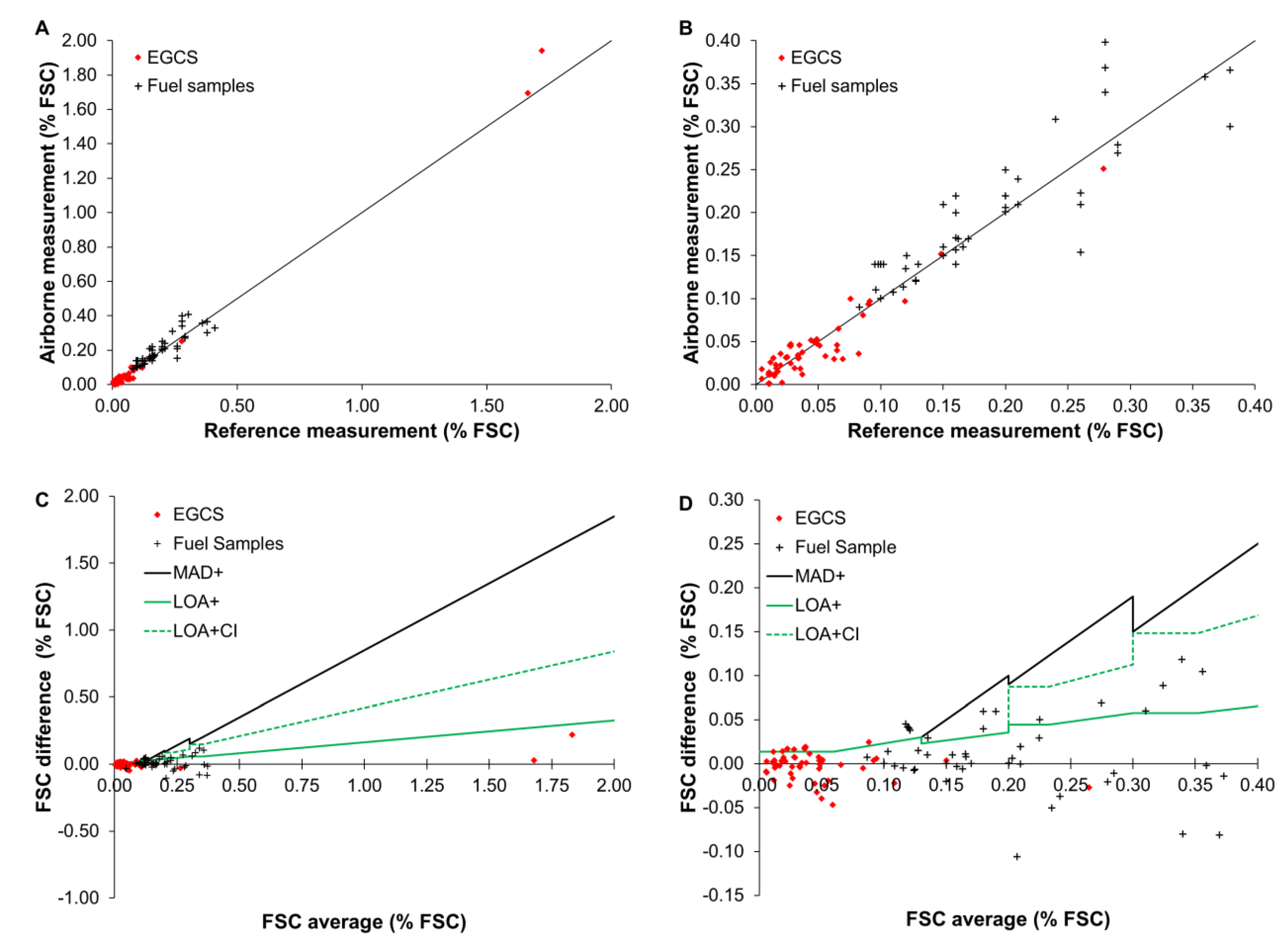
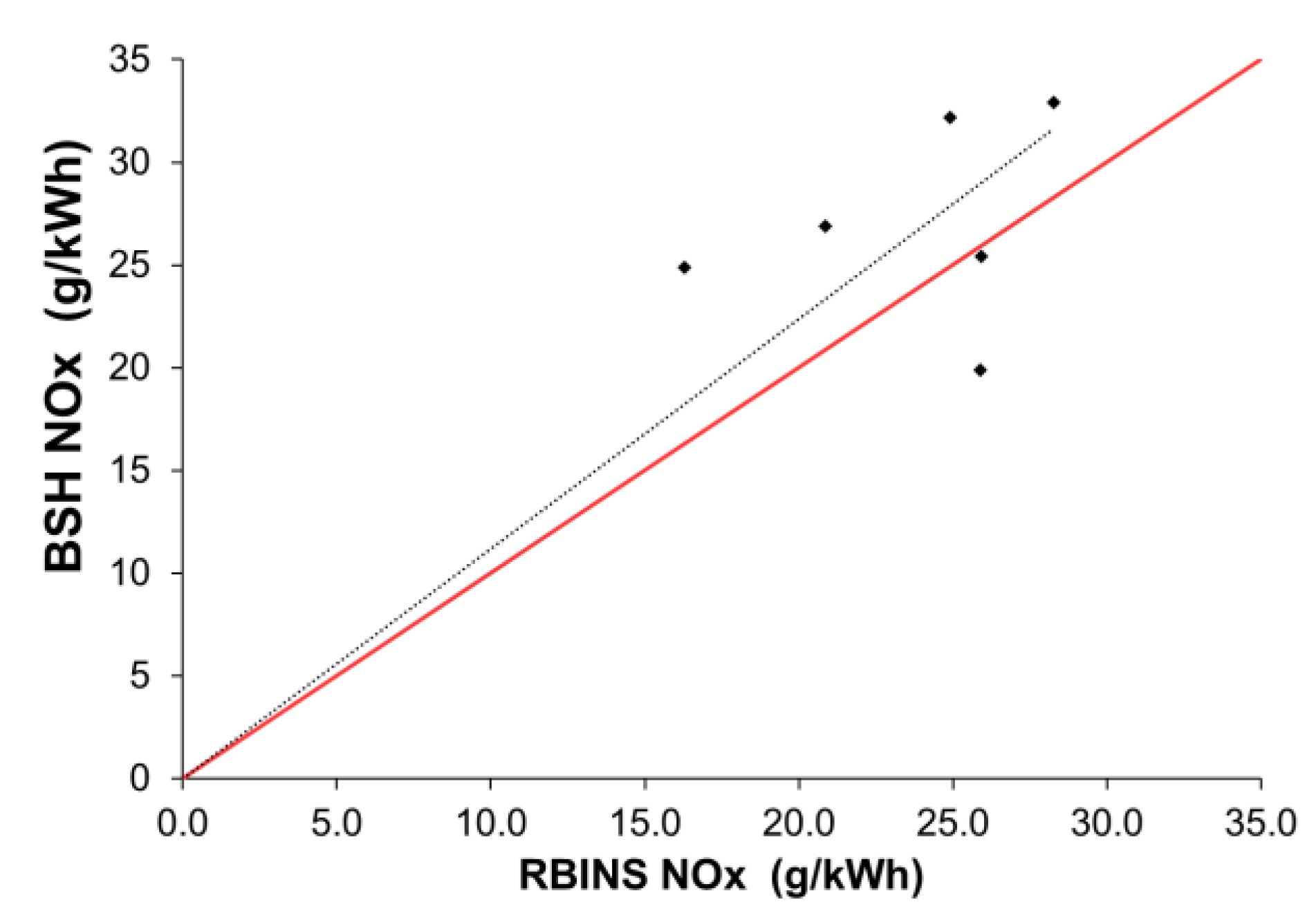
| Color Flag | CI | σ | FSC | NOx | |||
|---|---|---|---|---|---|---|---|
| Tops<2020 (%) | Tops>2020 (%) | Tops Tier I (g NOx/kWh) | Tops Tier II (g NOx/kWh) | Tops Tier III (g NOx/kWh) | |||
| Yellow | 68% | 1 | 0.15 | 0.13 | 25 | 20 | 6 |
| Orange | 95% | 1.96 | 0.20 | 0.20 | 35 | 30 | 8 |
| Red | 99% | 2.576 | 0.40 | 0.30 | 55 | 45 | 9 |
| Year | Total Public Statements | Public Statements after Remote Measurement | % | Total Amount of Fines (EUR) | Amount of Fines after Remote Measurement (EUR) | % |
|---|---|---|---|---|---|---|
| 2016 | 3 | 3 | 100% | - | - | - |
| 2017 | 7 | 2 | 29% | 112,400 | 21,600 | 19% |
| 2018 | 13 | 4 | 31% | 668,800 | 261,200 | 39% |
| 2019 | 4 | 1 | 25% | 452,000 | 200,000 | 0% |
| 2020 | 1 | 0 | 0% | 136,000 | 0 | 0% |
| 2021 | 2 | 1 * | 50% | 56,000 | 0 | - |
| 2022 *** | 2 | 2 ** | 100% | 0 *** | 0 *** | 100% |
| Total | 32 | 13 | 41% | 1,425,200 | 482,800 | 34% |
| Reference Data | Degrees of Freedom (n) | Average (% FSC) | SDDiff (% FSC) | RSD | Tops-S | r * |
|---|---|---|---|---|---|---|
| Fuel sample | 49 | 0.20 | 0.007 | 3% | 0.873 | |
| EGCS | 56 | 0.10 | 0.005 | 4% | 0.997 | |
| Combined | 105 | 0.15 | 0.004 | 3% | 0.991 | |
| Green flag | 41 | 0.06 | 0.014 | 23% | 0.934 | |
| Yellow flag | 18 | 0.14 | 0.026 | 18% | 0.03 | 0.989 |
| Orange flag | 15 | 0.22 | 0.043 | 19% | 0.09 | |
| Red flag | 11 | 0.60 | 0.097 | 16% | 0.25 |
| Fixed Station a | Aircraft (FSC Only) b | Aircraft (FSC + NOx) c | Helicopter d | Port Inspections | RPAS e | |
|---|---|---|---|---|---|---|
| Hours of operation per year | 2450 | 96.1 | 94.8 | 60 | 200 | 425 |
| Average number of OGVs per hour | 1.85 | 12.8 | 10.3 | 10 | 0.6 | 0.8 |
| Average number of inspected ships per year | 4500 | 1232 | 980 | 600 | 110.0 | 325 |
| Average price per inspection | 20–25 € | 122 f–188 g € | 71 f–109 g € | 380 € | 550 € | 3923 € |
| No Remote Measurements | 100% Based on Remote Measurements | 1/3 Based on Remote Measurements | |
|---|---|---|---|
| Number of port inspections | 220 | 110 | 110 |
| Random inspections | 220 | - | 74 |
| Inspections after alert from aircraft | - | 110 | 36 |
| Confirmation rate | 2.7% | 43% | 16% |
| Number of confirmations | 5.94 | 55 | 17.6 |
| Cost port inspections | EUR 118,800 | EUR 59,400 | EUR 59,400 |
| Number of flight hours | 0 | 264.4 | 70 |
| Non-compliance rate | - | 4.0% | 4.0% |
| Number of inspection/hr | - | 13 | 13 |
| Price/flight hour | - | EUR 1576 * | EUR 1576 |
| Cost airborne monitoring | - | EUR 333,385 | EUR 110,320 |
| Combined cost | EUR 118,800 | EUR 392,785 | EUR 169,720 |
| Cost/confirmed violation | EUR 20,000 | EUR 8304 | EUR 9622 |
| Improvement | 0% | −58% | −52% |
Disclaimer/Publisher’s Note: The statements, opinions and data contained in all publications are solely those of the individual author(s) and contributor(s) and not of MDPI and/or the editor(s). MDPI and/or the editor(s) disclaim responsibility for any injury to people or property resulting from any ideas, methods, instructions or products referred to in the content. |
© 2023 by the authors. Licensee MDPI, Basel, Switzerland. This article is an open access article distributed under the terms and conditions of the Creative Commons Attribution (CC BY) license (https://creativecommons.org/licenses/by/4.0/).
Share and Cite
Van Roy, W.; Merveille, J.-B.; Scheldeman, K.; Van Nieuwenhove, A.; Van Roozendael, B.; Schallier, R.; Maes, F. The Role of Belgian Airborne Sniffer Measurements in the MARPOL Annex VI Enforcement Chain. Atmosphere 2023, 14, 623. https://doi.org/10.3390/atmos14040623
Van Roy W, Merveille J-B, Scheldeman K, Van Nieuwenhove A, Van Roozendael B, Schallier R, Maes F. The Role of Belgian Airborne Sniffer Measurements in the MARPOL Annex VI Enforcement Chain. Atmosphere. 2023; 14(4):623. https://doi.org/10.3390/atmos14040623
Chicago/Turabian StyleVan Roy, Ward, Jean-Baptiste Merveille, Kobe Scheldeman, Annelore Van Nieuwenhove, Benjamin Van Roozendael, Ronny Schallier, and Frank Maes. 2023. "The Role of Belgian Airborne Sniffer Measurements in the MARPOL Annex VI Enforcement Chain" Atmosphere 14, no. 4: 623. https://doi.org/10.3390/atmos14040623
APA StyleVan Roy, W., Merveille, J.-B., Scheldeman, K., Van Nieuwenhove, A., Van Roozendael, B., Schallier, R., & Maes, F. (2023). The Role of Belgian Airborne Sniffer Measurements in the MARPOL Annex VI Enforcement Chain. Atmosphere, 14(4), 623. https://doi.org/10.3390/atmos14040623











